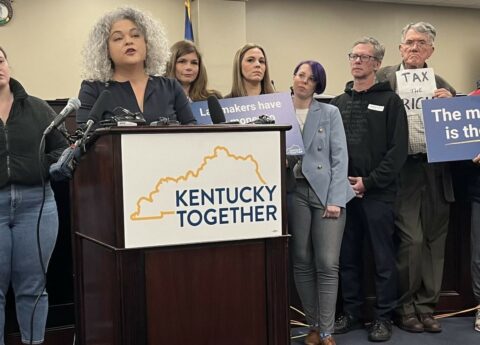Kentucky’s budget is a critical but often overlooked tool for improving health in the commonwealth. A new report from the Kentucky Center for Economic Policy (KCEP) shows how our health outcomes – generally poor as well as disparate across communities – are related to tax and budget choices. While cuts to education, public health, infrastructure and other budget areas over the last decade have harmed Kentuckians’ ability to be healthy, the 2020 budget is an opportunity to recommit to building thriving communities.
“Too many Kentuckians face circumstances that make it hard to be healthy. We work in jobs that pay too little to afford quality child care and housing. We are exposed to air pollution and lack access to clean drinking water, exercise opportunities and healthy food,” KCEP Senior Policy Analyst and the report’s author Dr. Ashley Spalding, said. “But smart policy choices can remove barriers to health. From making child care more affordable and strengthening environmental protection to building sidewalks and improving our road infrastructure so folks can access jobs, doctors’ offices and grocery stores, there is a lot we can do.”
The report, “Critical Investments for a Healthier Kentucky,” explains that while improved access to health care through the Medicaid expansion is a critical piece of becoming a healthier state, “health care activities” make up just 20% of the factors shaping health. The remaining 80% are related to the environment, social and economic conditions, and behavior – all of which are impacted by state budget choices.
For example, having more education is strongly linked with greater socioeconomic outcomes and lasting positive effects on health. But in the last decade, the state has deeply cut preschool, K-12 and higher education.
The report examines the state’s poor health outcomes – for instance Kentucky is ranked worst out of all 50 states for cancer deaths and 3rd worst for frequent mental distress – but also how some communities face greater barriers to health than others:
- Structural racism creates additional barriers to health. Income inequality and segregation impact the opportunities Kentuckians of color have to be healthy, reflected in disparate outcomes. For example, black Kentuckians die more than two years earlier than white Kentuckians, and black babies are twice as likely as white babies to be born with low birthweight.
- Challenges in the rural, eastern part of the state – related in part to a long reliance on a single industry in decline (coal) – show up in poor health outcomes in the region. For example, of the 10 worst-ranking counties in the health outcomes map below, 6 had drinking water violations and all 10 had a lower share of the population with at least some college than the state overall.
“The color of your skin and where you live shouldn’t determine whether or not you get to enjoy good health,” Spalding said. “But when the state fails to adequately invest in high-quality public services for everyone – things like early childhood education, public health and disaster preparedness, and clean drinking water – the consequences are worse for communities that already face significant barriers.”
The report sets benchmarks for improvement and recommends specific ways to strengthen investments in six main areas: expand access to preschool, adequately fund K-12 education and reverse higher education cuts; invest in supports that increase economic security; fund public health; invest in infrastructure and the environment; and make smart investments in interventions, alternatives and rehabilitation to reduce incarceration. To make these investments possible, the report recommends returning to a graduated income tax and cleaning up other special interest tax breaks.
“The data doesn’t paint a rosy picture. We know many Kentuckians struggle with poor health caused by a lack of investment,” Spalding said. “But we cannot afford to be fatalistic. There are proven ways to invest directly in our health. We can raise revenue to plow into our communities and live happier, healthier, more productive lives.”
Click here to read the full report.



